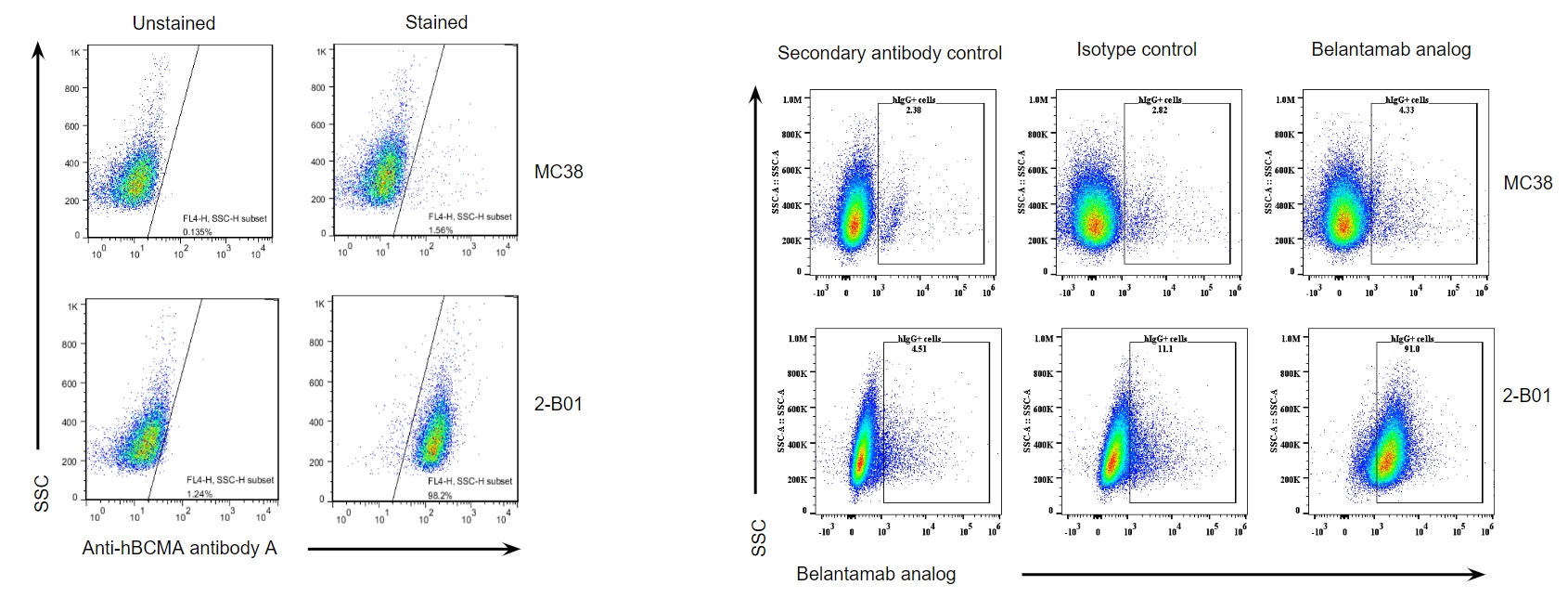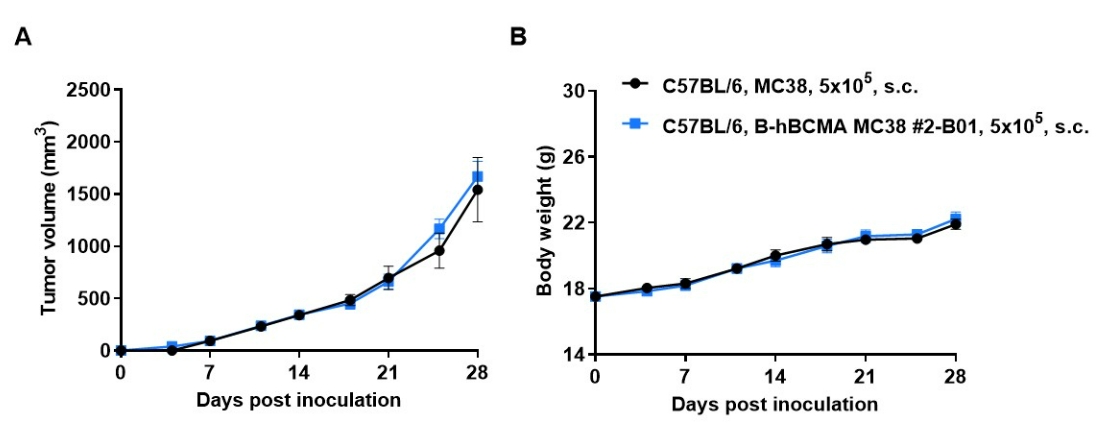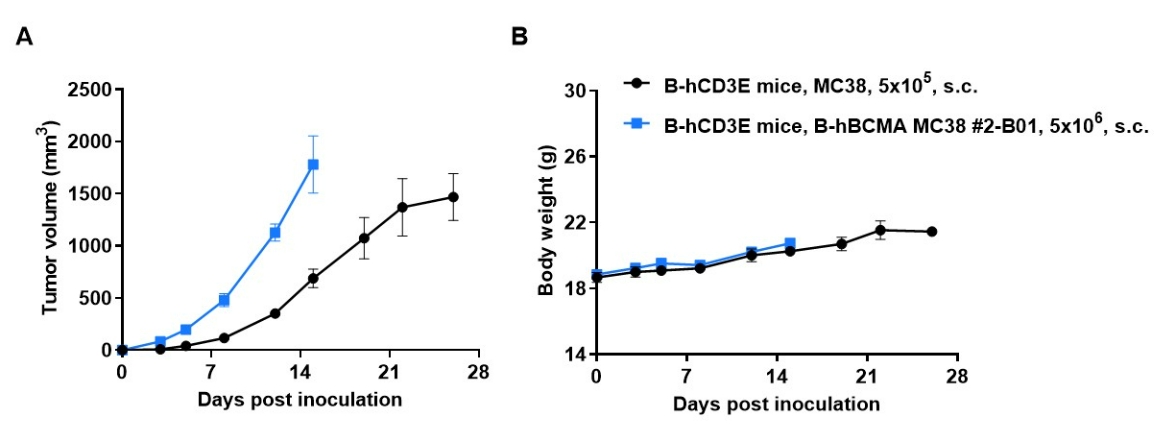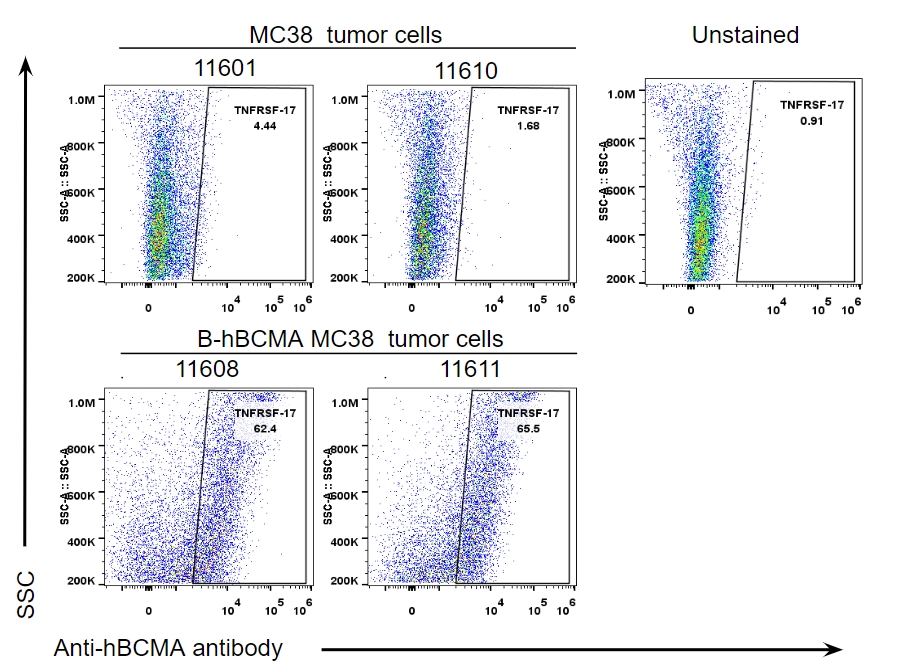Basic Information
Description
The MC38 cell line is derived from C57BL/6 murine colon adenocarcinoma cells. The cell line is a commonly used murine model for colorectal carcinoma.
-
Targeting strategy

-
The exogenous promoter and human BCMA coding sequence were inserted into the mouse ROSA26 locus of wild MC38 cell lines.
-
Protein expression analysis

-

BCMA expression analysis in B-hBCMA MC38 cells by flow cytometry.
Single cell suspensions from wild-type MC38 and B-hBCMA MC38 cultures were stained with species-specific anti-BCMA antibody A (provide a client) and Belantamab analog (in house). Human BCMA was detected on the surface of B-hBCMA MC38 cells but not wild-type MC38 cells. The 2-B01 clone of B-hBCMA MC38 cells was used for in vivo experiments.
-
Tumor growth curve & Body weight changes

-

Subcutaneous homograft tumor growth of B-hBCMA MC38 cells.
B-hBCMA MC38 cells (5×105) and wild-type MC38 cells (5×105) were subcutaneously implanted into C57BL/6 mice (female, 5-8-week-old, n=5). Tumor volume and body weight were measured twice a week. (A) Average tumor volume ± SEM. (B) Body weight (Mean± SEM). Volume was expressed in mm3 using the formula: V=0.5 X long diameter X short diameter2. As shown in panel A, B-hBCMA MC38 cells were able to establish tumors in vivo and can be used for efficacy studies.

Subcutaneous homograft tumor growth of B-hBCMA MC38 cells.
B-hBCMA MC38 cells (5×105, 5×106) and wild-type MC38 cells (5×105) were subcutaneously implanted into B-h4-1BB mice (female, 7-week-old, n=6). Tumor volume and body weight were measured twice a week. (A) Average tumor volume. (B) Body weight. Volume was expressed in mm3 using the formula: V=0.5 X long diameter X short diameter2. As shown in panel A, B-hBCMA MC38 cells were able to establish tumors in vivo and can be used for efficacy studies. Values are expressed as mean ± SEM.

Subcutaneous tumor growth of B-hBCMA MC38 cells.
B-hBCMA MC38 cells (5×106) and wild-type MC38 cells (5×105) were subcutaneously implanted into B-hCD3E mice (female, 6-8-week-old, n=6). Tumor volume and body weight were measured twice a week. (A) Average tumor volume. (B) Body weight. Volume was expressed in mm3 using the formula: V=0.5 X long diameter X short diameter2. Results indicate that B-hBCMA MC38 cells were able to establish tumors in vivo and can be used for efficacy studies. Values are expressed as mean ± SEM.
-
Protein expression analysis of tumor cells

-

BCMA expression evaluated on B-hBCMA MC38 tumor cells by flow cytometry.
B-hBCMA MC38 cells were subcutaneously transplanted into C57BL/6 mice (n=5), and on 36 days post inoculation, tumor cells were harvested and assessed for human BCMA expression by flow cytometry using anti-human BCMA antibody A (provide a client). As shown, human BCMA was expressed on the surface of tumor cells. Therefore, B-hBCMA MC38 cells can be used for in vivo efficacy studies of novel BCMA therapeutics.
-
Protein expression analysis of tumor tissue

-

BCMA expression evaluated on B-hBCMA MC38 tumor cells by flow cytometry.
B-hBCMA MC38 cells were subcutaneously transplanted into B-hCD3E mice (n=6). Upon conclusion of the experiment, tumor cells were harvested and assessed for human BCMA expression by flow cytometry using anti-human BCMA antibody Belantamab analog (in house). As shown, human BCMA was highly expressed on the surface of tumor cells. Therefore, B-hBCMA MC38 cells can be used for in vivo efficacy studies evaluating novel BCMA therapeutics.


